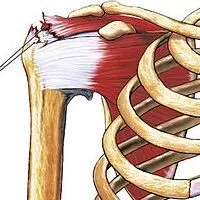Innovative Device Inspired by Python Teeth Enhances Rotator Cuff Repairs, reveals research

Researchers have found that a novel device inspired by the unique structure of python teeth significantly enhances the strength of rotator cuff repairs. A research team from Columbia University, led by Stavros Thomopoulos, PhD, came to this conclusion while seeking to improve post-operative outcomes for patients undergoing common orthopedic surgery. The study was published in the journal Science Advances.
Rotator cuff tears are among the most prevalent orthopedic injuries, affecting approximately 40% of Americans over 65 years old. With around 600,000 repair surgeries performed annually in the U.S., current techniques, which primarily rely on sutures to reattach tendons to shoulder bones, often fail. The sutures can slice through tendons over time, especially where stress is highest, leading to failure rates ranging from 20% in younger patients to a staggering 94% in elderly patients with severe tears. The “cheesewiring effect,” wherein sutures cut through tendons, significantly contributes to these high failure rates.
The inward-curving teeth of pythons, which prevent prey from escaping without tearing flesh, Thomopoulos and colleagues developed a 3D-printed device to improve tendon-bone attachment. The device is composed of small biocompatible plastic rectangles studded with curved teeth, optimized through experimentation with different curvature ratios, tooth arrangements, and spacing.
The researchers conducted trials using five paired shoulder joints from human cadavers. They simulated rotator cuff tears and performed conventional double-row suture repairs on some, while others were repaired using the python-tooth device. The devices, measuring 15.5-17.5 mm by 6-8 mm and carrying 13 teeth each about 3 mm high, were tested for their ability to withstand strain.
-
Repairs incorporating the python-tooth device exhibited an average increase in maximum force (strength) of 83% compared to conventional suture repairs.
-
The optimal tooth curvature ratio was found to be 2.5, which prevented cutting while effectively grasping bovine tendon samples.
-
The customizability of 3D printing allows for patient-specific designs, enhancing the fit and effectiveness of the device.
The significant improvement in repair strength suggests that this device could dramatically reduce the high rerupture rates currently observed in rotator cuff surgeries. The python-tooth device’s ability to gently yet firmly grasp tendons addresses the mechanical failures associated with traditional suturing techniques.
This innovative approach, holds great potential for improving the durability and success of rotator cuff repairs. By nearly doubling the repair strength, the python-tooth device could significantly enhance postoperative outcomes and reduce the high rates of rerupture seen with current techniques.
Reference:
Kurtaliaj, I., Hoppe, E. D., Huang, Y., Ju, D., Sandler, J. A., Yoon, D., Smith, L. J., Betancur, S. T., Effiong, L., Gardner, T., Tedesco, L., Desai, S., Birman, V., Levine, W. N., Genin, G. M., & Thomopoulos, S. (2024). Python tooth–inspired fixation device for enhanced rotator cuff repair. Science Advances, 10(26). https://doi.org/10.1126/sciadv.adl5270



